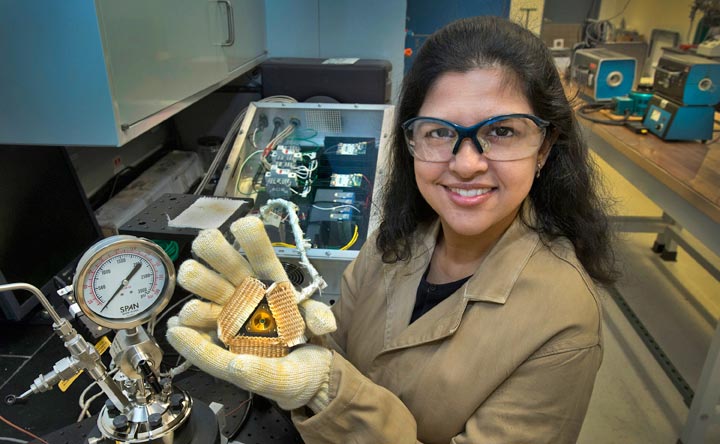Women @ Energy: Simerjeet Gill
November 5, 2014
 enlarge
enlarge
Simerjeet Gill of the U.S. Department of Energy's Brookhaven National Laboratory works on materials in extreme environments, including supercritical CO2, which is an initiative in the President's fiscal year 2015 budget proposal.
The following profile was published by the Department of Energy's Office of Economic Impact and Diversity for the Women @ Energy series, which showcases women who are helping change the world, ensuring America’s security and prosperity through transformative science and technology solutions. Meet the other scientists profiled in the Women @ Energy series.
Simerjeet Gill of the U.S. Department of Energy's Brookhaven National Laboratory works on materials in extreme environments, including supercritical CO2, which is an initiative in the President’s fiscal year 2015 budget proposal. Her work is focused on utilizing synchrotron X-ray techniques and microscopy to investigate materials in extreme environments to advance applied energy technologies for nuclear and enhanced geothermal systems. She has developed in-situ reaction cell and is the lead scientist on a "first-light" experiment to study corrosion in nuclear materials when operations begin at the National Synchrotron Light Source II in 2015. Before joining the Lab in 2010, Simerjeet was a research assistant at Texas Tech University, where she earned her Ph.D in inorganic chemistry. She earned BS and MS from Honours School in Chemistry at Panjab University in India.
1) What inspired you to work in STEM?
I have always been intrigued by science. When I was a 10-year-old kid, I was curious about simple everyday things—such as why eyes produce tears while cutting onions, why apples and pears turn brown after being cut—and I would read to find answers. Whether I was home or in a chemistry lab, I loved mixing things, watching changes happen, and learning reasons why things did what they did. My passion for chemistry crystallized thanks to my high school chemistry teacher. She was a very good teacher and made chemistry class very interesting, which encouraged me to study harder and learn more. Also, my father taught me to question things around me, and he encouraged me to think logically and reason critically.
I believe my curiosity, good teachers, and father inspired me to major in STEM. After high school, I majored in Chemistry at Panjab University’s Honours School in Chemistry and I never looked back.
2) What excites you about your work at the Energy Department?
The possibilities and freedom to pursue ideas to solve problems is very exciting. Working in the Department of Energy not only provides me with access to state-of-the-art facilities like the National Synchrotron Light Source (NSLS) and future NSLS-II, I also get to work with world-class scientists who are leaders in their fields. When I developed a reaction cell to watch corrosion as it happens at a synchrotron facility, I got to work with beamline scientists, design engineers, corrosion experts, and a safety team. Teaming up with these experts for an experiment was truly a rewarding experience. In my current projects, I am collaborating with outstanding scientists from Brookhaven Lab and other institutions to develop materials for nuclear energy and, so far, the journey has been great.
3) How can our country engage more women, girls, and other underrepresented groups in STEM?
I believe exposure to STEM at early age is very important and has a big impact. By exposing young minds to practical science early on, engaging them with projects that directly impact everyday life, and encouraging them to think critically, we can stimulate and engage them. Providing opportunities to meet leading scientists—both male and female—to learn about their work could also be inspirational.
4) Do you have tips you'd recommend for someone looking to enter your field of work?
Talk to professionals who are working in the field. Be confident and ask them questions. They are an excellent source of information and you will be amazed how encouraging people can be. Take courses in subjects you like and do short projects, build teams, and collaborate. Network with professionals and seek guidance from a role model or mentor.
5) When you have free time, what are your hobbies?
My hobbies are traveling, and learning about new cultures and cuisines around the world. I have new found hobby too—my 15-month-old daughter. It is a lot of fun to watch her grow and do new things.
2014-5271 | INT/EXT | Newsroom









